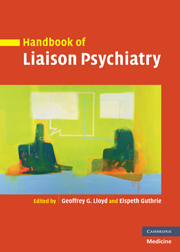Book contents
- Frontmatter
- Contents
- List of contributors
- Preface
- Part I Basic skills
- Part II Common psychiatric problems across the general hospital
- Part III Working with specific units
- Part IV Treatment
- 33 Psychopharmacological treatment in liaison psychiatry
- 34 The role of psychological treatments
- 35 Problem cases
- Part V Different treatment settings
- Index
- References
33 - Psychopharmacological treatment in liaison psychiatry
from Part IV - Treatment
Published online by Cambridge University Press: 10 December 2009
- Frontmatter
- Contents
- List of contributors
- Preface
- Part I Basic skills
- Part II Common psychiatric problems across the general hospital
- Part III Working with specific units
- Part IV Treatment
- 33 Psychopharmacological treatment in liaison psychiatry
- 34 The role of psychological treatments
- 35 Problem cases
- Part V Different treatment settings
- Index
- References
Summary
Keywords
- Type
- Chapter
- Information
- Handbook of Liaison Psychiatry , pp. 763 - 794Publisher: Cambridge University PressPrint publication year: 2007
References
- 6
- Cited by



